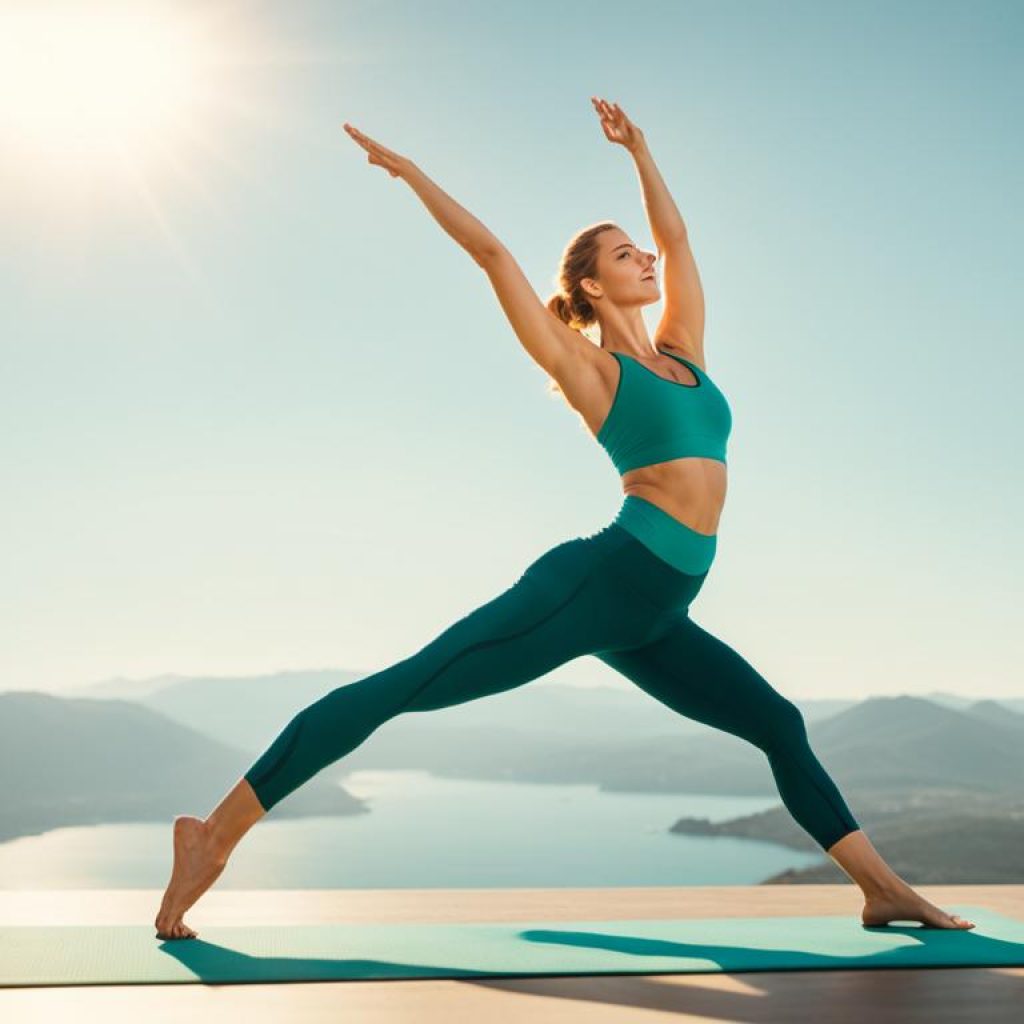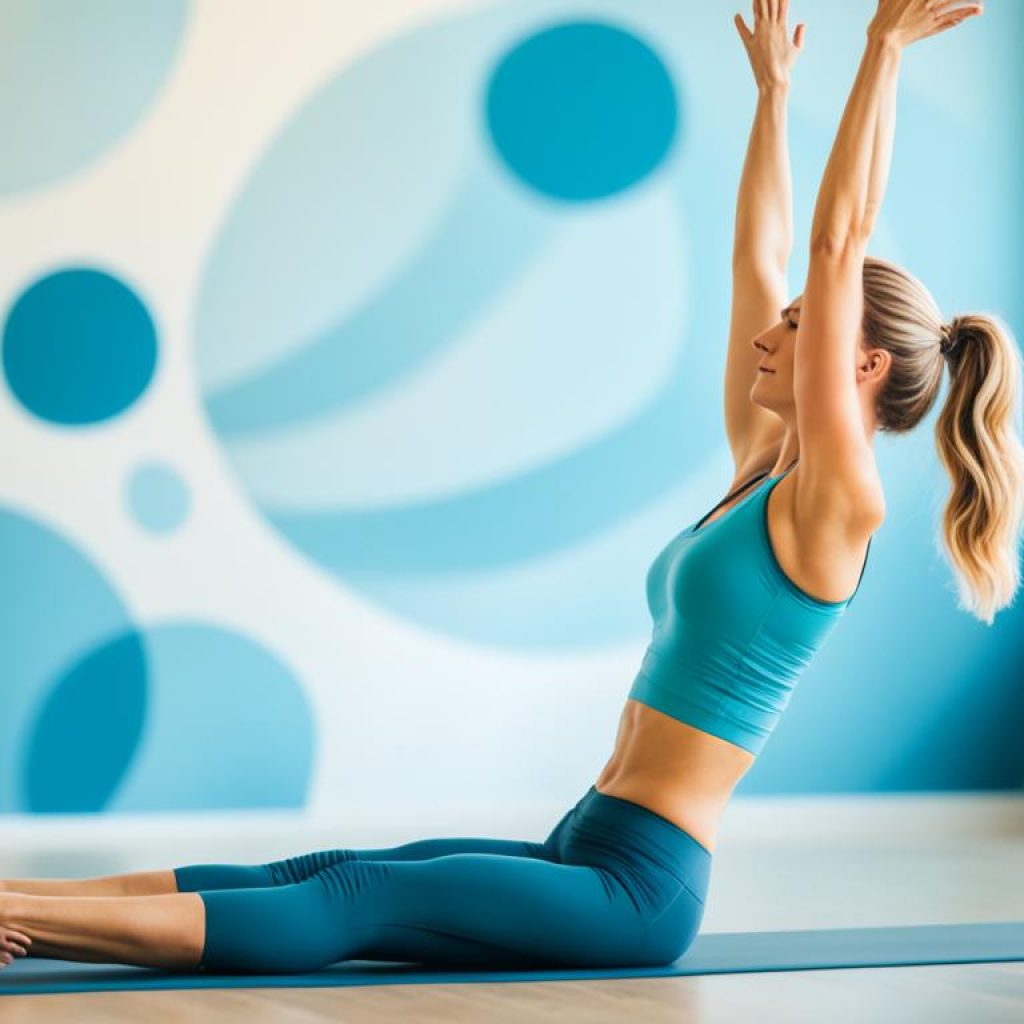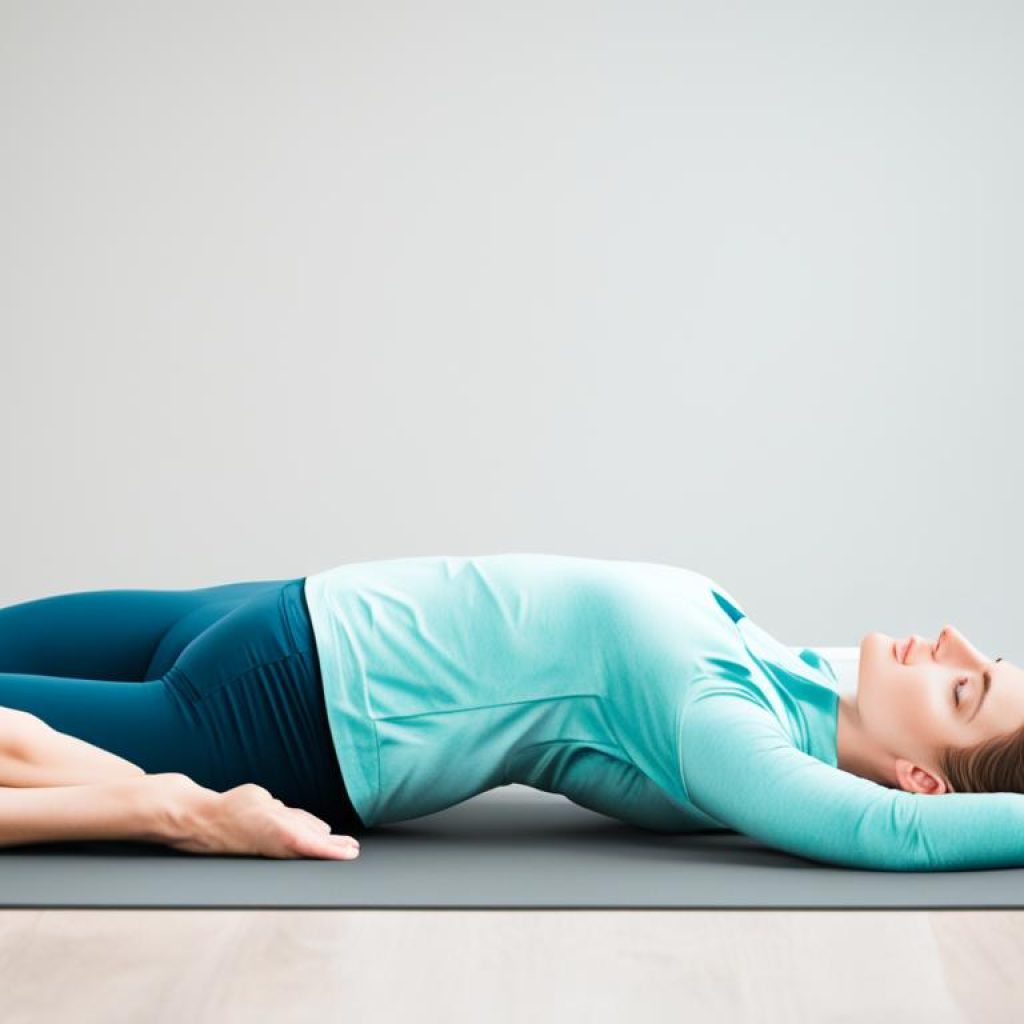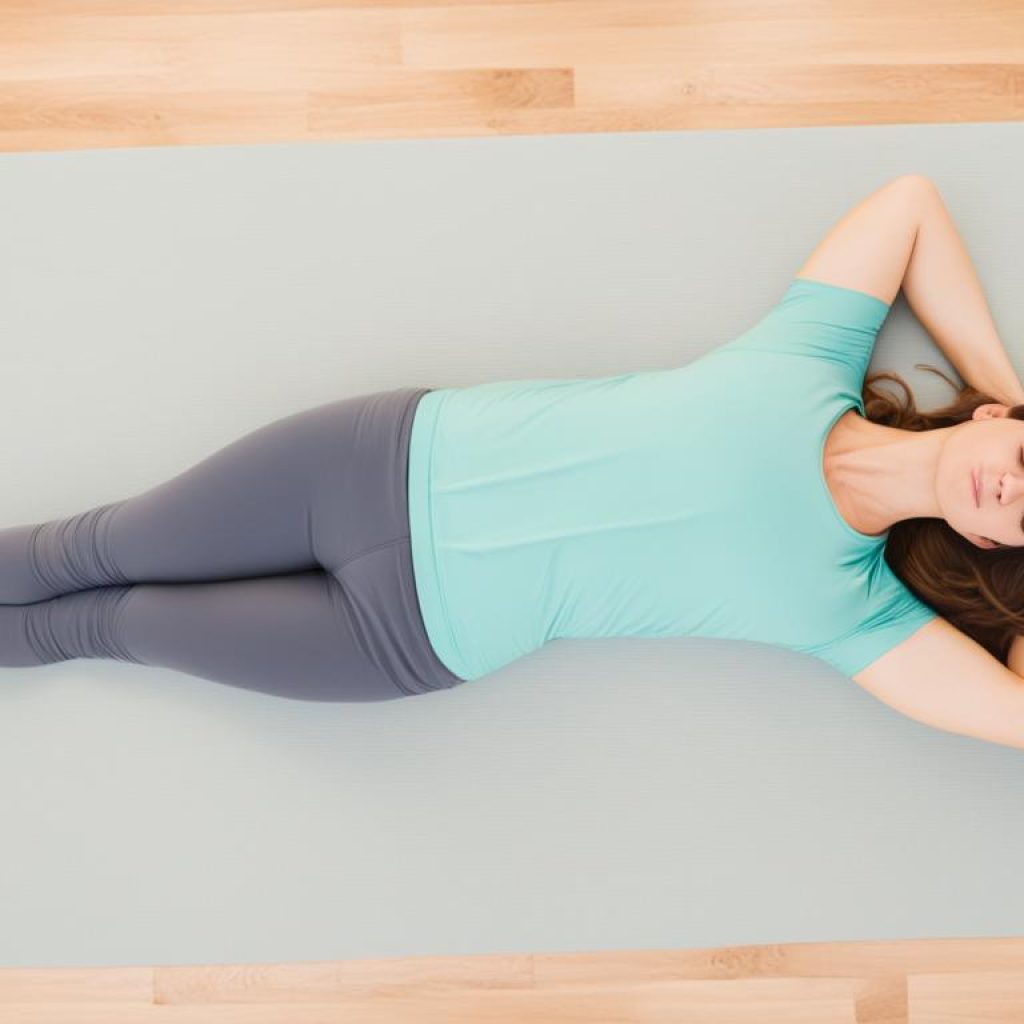Did you know that exercise can have a profound impact on your mood and mental well-being? It’s true! Research has shown that physical activity, such as yoga, can be an effective therapy for managing depression and improving overall mental health. With its unique combination of movement, meditation, and deep breathing, yoga offers a holistic approach to fitness that nurtures both the body and the mind.
Yoga has been found to increase serotonin levels in the brain, which can help elevate mood and promote a greater sense of well-being. By incorporating specific yoga poses into your regular exercise routine, you can tap into the incredible mental health benefits that yoga has to offer and experience a greater sense of calm, balance, and positivity in your life.
Key Takeaways:
- Exercise, such as yoga, can have a powerful impact on mood and mental well-being.
- Yoga increases serotonin levels in the brain, leading to improved mood and well-being.
- Specific yoga poses can provide mental health benefits and promote a greater sense of calm and balance.
- Incorporating yoga into your regular exercise routine can help alleviate symptoms of depression and anxiety.
- Joining a yoga community or taking yoga classes can provide social support and enhance the healing journey.
The Power of Easy Pose (Sukhasana)
Easy Pose, also known as Sukhasana, is a classic yoga position that can be an effective tool for dealing with anxiety, depression, and chronic stress. By sitting on the floor with crossed legs and a straight spine, this posture allows the base of the spine to connect with the earth, creating a deep sense of grounding and stability.
The symmetrical nature of Easy Pose helps to center and balance the practitioner, promoting a sense of clarity, confidence, and strength. By practicing Easy Pose with a focus on deep, relaxed breathing and attention to the heart center, individuals can experience a greater sense of calm and resilience in the face of adversity.
“Easy Pose allows us to connect with the earth and find stability in the midst of chaos.” – Yogi Jane
| Benefits of Easy Pose | How to Practice Easy Pose |
|---|---|
|
|
By incorporating Easy Pose into your regular yoga practice, you can tap into its grounding and calming effects, regain confidence, and cultivate clarity and strength within yourself.
Harnessing the Benefits of Downward Facing Dog Pose (Adho Mukha Svanasana)
Downward Facing Dog Pose, or Adho Mukha Svanasana, is a well-known yoga posture that offers a multitude of benefits for both the body and mind. This pose involves lifting the hips up while pressing the hands and feet into the ground, creating an inverted V-shape with the body. In addition to lengthening the spine and strengthening the arms, shoulders, and legs, Downward Facing Dog Pose also increases blood flow to the brain.
This increase in circulation can lead to greater mental clarity, improved energy levels, and enhanced ability to cope with stress and anxiety. Furthermore, this pose can release tension in the legs and shoulders, two common areas of the body that can hold stress and contribute to feelings of depression.

Practicing Downward Facing Dog Pose regularly can be a powerful tool in managing anxiety and depression symptoms, offering not only physical benefits but also mental and emotional relief. The combination of stretching and strengthening the body while increasing blood flow to the brain creates a holistic experience that promotes overall well-being.
By practicing Downward Facing Dog Pose, individuals can experience a sense of grounding, stability, and release, ultimately leading to a greater sense of calmness and balance in their daily lives.
Whether as part of a yoga practice or as a standalone pose, Downward Facing Dog offers a moment of self-reflection and mindfulness, allowing individuals to connect with their bodies and minds on a deeper level. Incorporating this pose into a regular routine can provide a much-needed respite from the challenges of anxiety and depression, bringing a sense of tranquility and renewed energy.
The Heart-Opening Benefits of Upward-Facing Dog Pose (Ūrdhva Mukha Svānāsana)
Upward-Facing Dog Pose, also known as Ūrdhva Mukha Svānāsana, is a powerful posture that can offer significant relief for individuals experiencing anxiety and depression. This pose involves lifting the chest and head while keeping the shoulders back, creating a deep opening and stretch in the front of the body.
The heart center plays a significant role in our emotional well-being, and Upward-Facing Dog Pose provides a unique opportunity to open and release emotional tension. As we lift and expand the chest, we allow ourselves to release pent-up emotions, promoting emotional clarity and a greater sense of well-being.
In addition to its emotional benefits, Upward-Facing Dog Pose also works to regulate the respiratory system. By practicing this pose, we engage in deep and balanced breathing, allowing for increased oxygen intake and improved lung capacity. This regulation of the respiratory system contributes to calming the mind, reducing anxiety, and promoting mental and physical balance.
Regular practice of Upward-Facing Dog Pose can lead to a greater sense of calm, emotional well-being, and improved mental and physical balance. By incorporating this pose into your yoga practice, you can experience the heart-opening benefits and enjoy a more balanced and centered approach to life.
Benefits of Upward-Facing Dog Pose
| Benefits | Description |
|---|---|
| Emotional Release and Clarity | By opening the heart center, this pose helps release pent-up emotions, promoting emotional clarity and a greater sense of well-being. |
| Regulating the Respiratory System | Engaging in deep and balanced breathing regulates the respiratory system, contributing to mental and physical balance and reduced anxiety. |
| Improved Mental and Physical Balance | Regular practice of Upward-Facing Dog Pose enhances overall balance, both physically and mentally, leading to a greater sense of calm and well-being. |
The Balancing and Calming Effects of Shoulderstand (Salamba Sarvangasana)
Shoulderstand, or Salamba Sarvangasana, is a powerful yoga pose for relieving anxiety and depression. This pose involves raising the legs and hips overhead while supporting the back with the hands, creating a vertical alignment of the body.
One of the key benefits of Shoulderstand is its ability to increase blood flow to the brain. This improved circulation enhances mental clarity, allowing individuals to experience a greater sense of balance and stability in their emotions. By promoting a calm and grounded state of mind, Shoulderstand can be an effective tool for managing anxiety and alleviating symptoms of depression.
In addition to its mental health benefits, Shoulderstand also has a physical impact on the body. This pose helps relieve tension in the neck and shoulders, which are common areas of the body where stress accumulates. By releasing this tension, individuals can experience a sense of relief and relaxation, further contributing to the emotional balance achieved through Shoulderstand.
It is important to note that Shoulderstand should be approached with caution and avoided if you have neck or shoulder problems, high blood pressure, or are menstruating. As with any yoga pose, it is recommended to practice under the guidance of a qualified instructor to ensure proper alignment and safety.
| Benefits of Shoulderstand (Salamba Sarvangasana) | Precautions |
|---|---|
|
|
“Shoulderstand increases blood flow to the brain, enhancing mental clarity, balancing emotions, and promoting a sense of calm and stability.”
Incorporating Shoulderstand into your yoga practice can provide both physical and mental health benefits. By nurturing a calm and balanced state of mind, this pose offers a powerful tool for managing anxiety and depression.

Standing Forward Fold Pose (Uttanasana) for Mental Clarity and Relaxation
Standing Forward Fold Pose, or Uttanasana, is a simple yet effective yoga posture that can promote mental clarity and relaxation. By gently bending forward and allowing the chest to touch the thighs, this pose helps release tension in the neck, shoulders, and back.
This deep forward fold position provides a gentle stretch that targets the tight muscles in the upper body, offering relief from accumulated tightness and stress. By focusing on the breath and allowing the body to surrender into the pose, you can experience a sense of release and let go of any lingering tension.
Not only does Standing Forward Fold help to release tension, but it also improves blood circulation, particularly to the brain. This increased blood flow delivers more oxygen and nutrients to the brain, which can enhance mental clarity and focus.
This pose can be particularly beneficial for individuals dealing with anxiety and depression. The grounding nature of Standing Forward Fold helps to calm an overwhelmed mind and brings a sense of stability to the body. The act of folding forward can also be symbolic of letting go of thoughts and worries, promoting a state of relaxation and peace.
Include Standing Forward Fold as part of your regular yoga practice to promote mental clarity, reduce stress, and cultivate a sense of calm and relaxation. Consistency and mindful awareness in this pose can contribute to an overall sense of well-being and improved mental health.
Finding Comfort and Support in Child’s Pose (Balasana)
Child’s Pose, or Balasana, is a restorative and comforting yoga posture that can be especially beneficial for individuals experiencing anxiety and depression. By kneeling on the mat and bending forward with the chest resting on the thighs, this pose creates a deep sense of grounding and support.
This grounding and comforting posture helps release tension in the spine, promoting a sense of relaxation and calming the nervous system. It offers immense comfort and can provide emotional solace during times of anxiety and depression. By practicing Child’s Pose regularly, individuals can cultivate a deeper sense of inner peace, comfort, and stability.

The Benefits of Child’s Pose (Balasana)
| Benefits | Description |
|---|---|
| Grounding and Comforting | Creates a deep sense of grounding and support, providing comfort during times of anxiety and depression. |
| Release Tension in the Spine | Helps release tension in the spine, providing physical relief and promoting relaxation. |
| Calms the Nervous System | Promotes a sense of calmness by soothing and balancing the nervous system. |
Corpse Pose (Savasana) for Deep Relaxation and Integration
Corpse Pose, or Savasana, is a powerful posture for managing anxiety and depression. Despite its name, Savasana is a gentle and comforting yoga position that promotes deep relaxation and the integration of energy and insights obtained during the practice. By lying flat on your back with arms stretched alongside your body, Savasana creates a calming and tranquil space for cultivating calmness and bliss. This gentle posture allows you to let go of tension and experience a profound sense of peace.
During Savasana, focus on your breath and let your body sink into the ground. Allow any stress or anxiety to melt away as you surrender to the present moment. Sink deeper into relaxation and let your mind become still.
Corpse Pose is a perfect way to end a yoga practice, allowing you to fully absorb the benefits of the previous poses and integrate them into your well-being. By practicing Savasana regularly, you can enhance your ability to relax, restore balance to your emotions, and experience deep states of calm and tranquility.

Benefits of Corpse Pose:
- Promotes deep relaxation and calmness
- Reduces anxiety and depression symptoms
- Enhances mental and emotional well-being
- Allows for the integration of energy and insights gained during the practice
- Restores balance and promotes a sense of peace
“Savasana is the ultimate surrender, a conscious letting go of everything. It is an invitation to relax, to release any tension, and to find tranquility within yourself.” – Yoga Teacher
Tips for a Blissful Corpse Pose:
- Find a quiet and comfortable space where you can lie down without interruption.
- Use a blanket or bolster under your knees or lower back for added support and relaxation.
- Close your eyes and focus on your breath, allowing it to flow naturally and effortlessly.
- Bring awareness to each part of your body, consciously relaxing and releasing any tension you may feel.
- Stay in Savasana for at least 5-10 minutes, or longer if desired, to fully experience its benefits.
Personal Integration
| Insights Gained | Energy Cultivated |
|---|---|
| Awareness of the present moment | Inner peace |
| Acceptance of thoughts and emotions | Sense of calmness |
| Self-reflection and introspection | Relaxation and rejuvenation |
| Release of tension and stress | Renewed energy and vitality |
Conclusion
Yoga for Mental Health is a powerful practice that can significantly improve mood and overall well-being. Incorporating yoga poses into a regular routine can provide numerous benefits, including increased serotonin levels, improved circulation, and enhanced mind-body connection. By embracing specific poses such as Easy Pose, Downward Facing Dog, Upward-Facing Dog, Shoulderstand, Standing Forward Fold, Child’s Pose, and Savasana, individuals can find relief from symptoms of anxiety and depression.
In addition to the physical and mental benefits, yoga also offers an opportunity for community support and social connection. Participating in yoga classes or joining a yoga community allows individuals to connect with like-minded individuals, share experiences, and receive support on their healing journey. This sense of community can further enhance the transformative power of yoga and foster a deeper sense of belonging and connection.
By incorporating yoga into a healing journey, individuals can cultivate self-awareness, resilience, and positivity. Yoga provides a holistic approach to mental well-being, combining physical movement, relaxation techniques, and mindfulness practices. Through regular practice and community support, individuals can tap into the transformative power of yoga, finding balance, healing, and improved mental health.
FAQ
What are some yoga poses for depression?
Some yoga poses that can help alleviate depression symptoms include Easy Pose, Downward Facing Dog Pose, Upward-Facing Dog Pose, Shoulderstand, Standing Forward Fold Pose, Child’s Pose, and Corpse Pose.
How can Easy Pose (Sukhasana) help with anxiety and depression?
Easy Pose provides grounding and stability, promoting clarity, confidence, and strength. By practicing this pose with deep, relaxed breathing and attention to the heart center, individuals can experience a greater sense of calm and resilience.
What are the benefits of Downward Facing Dog Pose (Adho Mukha Svanasana) for mental health?
Downward Facing Dog Pose increases blood flow to the brain, leading to mental clarity, improved energy levels, and enhanced ability to cope with stress and anxiety. It also releases tension in the legs and shoulders, which are common areas that contribute to feelings of depression.
How can Upward-Facing Dog Pose (Ūrdhva Mukha Svānāsana) help alleviate anxiety and depression?
Upward-Facing Dog Pose opens the heart center, promoting emotional release and clarity. It also regulates the respiratory system, encourages deeper breathing, and helps achieve a greater sense of calm, emotional well-being, and balance.
What are the benefits of Shoulderstand (Salamba Sarvangasana) for anxiety and depression relief?
Shoulderstand increases blood flow to the brain, improving mental clarity, balancing emotions, and promoting a sense of calm and stability. It also relieves tension in the neck and shoulders, which are common areas that hold stress and contribute to feelings of depression.
How does Standing Forward Fold Pose (Uttanasana) contribute to mental clarity and relaxation?
Standing Forward Fold Pose releases tension in the neck, shoulders, and back, directing blood flow to the brain and increasing oxygenation for improved mental clarity. It promotes a sense of calm, relaxation, and enhanced well-being.
How does Child’s Pose (Balasana) provide comfort and support for anxiety and depression?
Child’s Pose creates a deep sense of grounding and support, releasing tension in the spine and calming the nervous system. It offers emotional comfort during times of anxiety and depression, cultivating inner peace, comfort, and stability.
What are the benefits of Corpse Pose (Savasana) for anxiety and depression?
Corpse Pose is a gentle and comforting posture that promotes deep relaxation and integration of energy and insights gained during the practice. It contributes to a sense of calmness, tranquility, and bliss, offering relief from anxiety and depression symptoms.
How can yoga help with mental health?
Yoga can have a positive impact on mental health by improving mood, reducing symptoms of depression, increasing serotonin levels in the brain, and promoting a greater sense of calm and balance through physical movement, meditation, and breathing techniques.
Why is it beneficial to incorporate yoga into a healing journey for anxiety and depression?
Yoga provides a holistic approach to mental well-being, combining physical exercise, relaxation techniques, and mind-body connection. It can help individuals cultivate self-awareness, resilience, and positivity, enhancing their healing journey and promoting overall mental health.
Leave a Reply